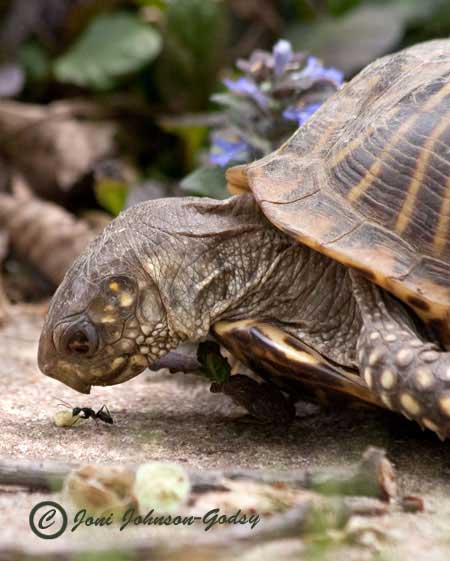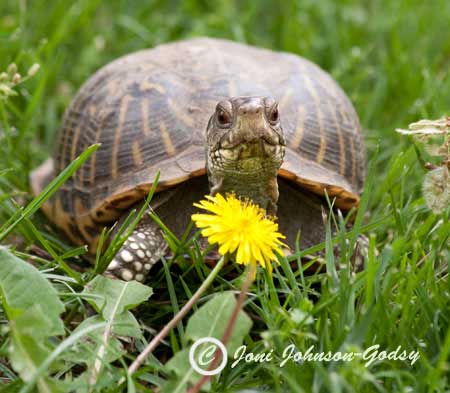My dog Pawsome found a box turtle in the garden today when we stepped outside at lunch time. He was a bit shy at first but eventually “came out of his shell” and went about his business.
The step from the garden onto our concrete patio is a BIG one if you are a turtle!

Feeling a bit perplexed and out of place, he looked me over for a bit…

And then he decided that it was time to explore our deck.

On the smooth surface of the deck, one can build up some real “speed”… COOL!

These purple flowers sure look interesting. Wonder what one might find in here?

Oh, I see this little Skink likes purple flowers too…

An ant came out from under the turtle’s shell. When the turtle noticed it, he went from a poky little chap into a streamlined hunter (well, as streamlined as a turtle will ever be). The chase was on as he “raced” after the ant…

In the end it wasn’t the ant that he was after, but rather the vegetable matter that the ant was carrying. GULP! And the ant went along on his way.

Hmmm…wonder what is over there?

This pretty thing sure looks tasty…


Chomp! Gulp…
(This by the way, is why we DO NOT use weed killers on our property!)

Ahhhhh! Lip smackin good!

There is nothing like a nice dandelion mustache to show for a good meal…

Time to mosey….see ya!

SOME BOX TURTLE FUN FACTS:
Box turtles can live to be 100 years old.
Box turtles are becoming increasingly threatened in the wild due to habitat loss (woodlands being converted into subdivisions, roads and farms) and the pet trade. Pet traders are pulling them from the wild and selling them at alarming rates. Over half of them die in captivity. It is difficult to adequately meet the nutritional and physiological needs of a box turtle in captivity. Most are anemic and sickly. So teach little Johnny that the best place for the box turtle he has just found… is exactly where he found it!
A box turtle stays within about a half mile range of where it was born, all it’s life. If it is caught and released somewhere else, it will spend the rest of it’s life trying to find it’s way back to it’s original range.
Female box turtles lay eggs in late spring, usually around 4-6. Their reproductive cycle is very slow. They only need to mate every four years and are able still to lay fertilized eggs each year.
The next time you see a box turtle, ask him how old he is. His first birthday could date back to the time when automobiles were first invented!
